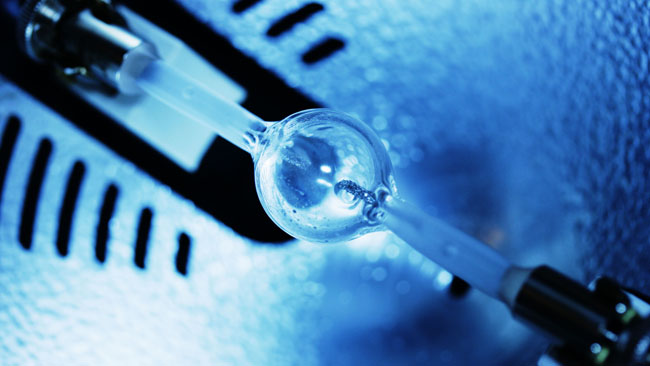
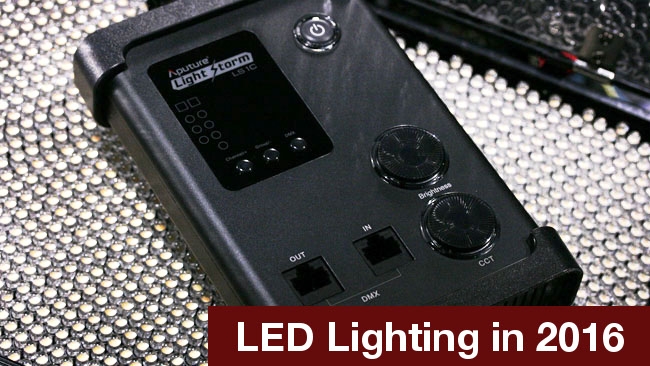 Aputure Lightstorm LS1C
Aputure Lightstorm LS1C
When and why LED lighting makes sense for modern productions (and why other options may still make more sense in certain situations).
The progress of LED lighting technology is something we talk about a lot. It's currently advancing at such a breathtaking rate that we're going to keep talking about it. We've complained in the past that it's actually more expensive than alternative technologies, for less actual effectiveness. Is that still true?
What makes most LED lighting practical is that modern cameras really don't require much light, so LEDs, which are still most often limited to fairly low power levels below 100W, are practical. This has long been a reason to greatly respect some of the work that was done in the days of extremely insensitive film and extremely inefficient lights; creating good results where every sliver of light requires a massive, multi-thousand-watt lighting device is hard work.
Modern needs
Some of the early colour processes had single-digit sensitivity and, much as we complain now that ISO 400 cameras are insensitive, they're still more than six stops faster than 5 ASA 3-strip Technicolor. Nevertheless, lighting modern productions, which may suffer directors who lack the ability or inclination to establish reliable blocking, sometimes need big soft sources, large enough and distant enough to avoid objectionable falloff as people move around. Generally, this means punching light through diffusion or off a bounce, which, necessary as it is, remains catastrophically inefficient from an optical point of view. It can require a lot of sheer power, even with cameras capable of practically starlight performance.
In these sorts of setups, new technology has created some neat tricks, such as the four-by-four arrays of foot-square Litepanels, or VersaTile. While the edge-lit VersaTile is less efficient than the direct-driven Litepanel, it produces a more even field. Both are probably a more efficient way to create soft light than blowing an HMI through a four-by-four panel of equivalent diffusion, since so much of the light bounces back in that case, although it's now quite widely recognised that LED of the early-Litepanel generation often had terrible colour performance and were usually more expensive than HMI per unit of sheer output – although that may be changing.
LED value?
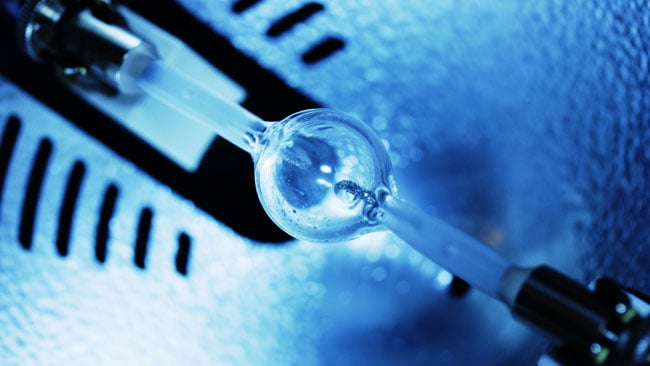 Some types of LED can barely exceed the efficiency of HMI, although colorimetry can vary.
Some types of LED can barely exceed the efficiency of HMI, although colorimetry can vary.
Mole-Richardson, from whom it's hard to take much based on its impressive history, charges around $4500 for the 900-watt SeniorLED daylight fresnel, claiming it "exceeds output of 1200W HMI." It had better; it's nearly $570 more money, or a 15% increase. The company's own numbers indicate that the HMI produces 736 footcandles to the daylight LED's 1000. 15% more money for 26.3% more photons is, just barely, worth it, at least on paper, if efficiency is your prime motivation. It isn't always, of course, and the overall evaluation must involve a complex combination of power consumption, portability, purchase price and quality of light, in terms of both character and colour. Either way, it's unlikely that many 1200W HMIs are going to be sold off on this slim basis.
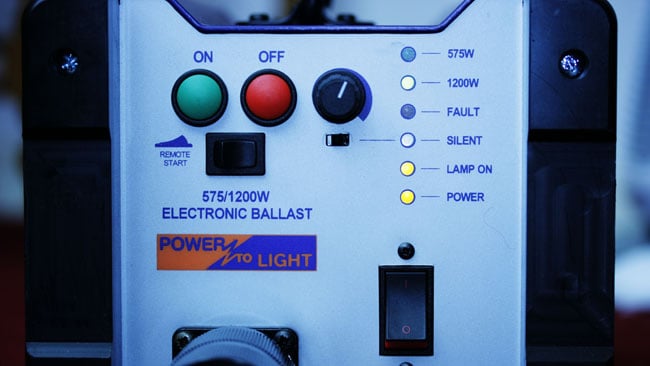 No current LED has the power density of a 1200W HMI.
No current LED has the power density of a 1200W HMI.
All the same, LED fresnels from companies just such as Mole and Arri do have one key advantage over HMI: they're usually available in tungsten as well as daylight. The idea that daylight is more useful than tungsten is mainly based on the fact that converting daylight to tungsten is less lossy than vice versa, and possibly also on the fact that artificial daylight has traditionally been more expensive and therefore difficult to get. But a key feature of LED is its ability to create efficient tungsten light. At 900W, Mole tells us the 3200K SeniorLED is roughly equivalent to a 5K tungsten (company numbers are 1000 over 875 foot candles at ten feet), and a 5K can't be run on location without an expensive generator in most parts of the world. That's a very considerable advantage.
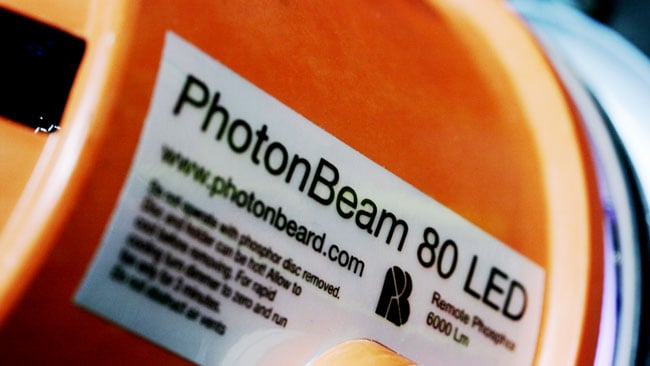 Remote-phosphor LEDs, such as this Photon Beard redhead, produce hard tungsten light with great efficiency.
Remote-phosphor LEDs, such as this Photon Beard redhead, produce hard tungsten light with great efficiency.
Against HMI or fluorescent, though, the advantage is, as we've seen before, less obvious. LED technology, in general, can be made more efficient than both, although that's mainly achieved by ensuring that a greater proportion of the light output comes directly from the blue LED and less from the yellow-emitting phosphor. The conversion is inefficient, so the bluer the light, the more efficient an LED tends to be, but also the spikier and more difficult its spectrum becomes. The tungsten SeniorLED is about 20% dimmer than the daylight, but enjoys a 95 CRI over the daylight's 90, and this is a very nice illustration of the physics behind the light source.
It's worth a brief digression here to point out that many companies rely on a colour rendering index (CRI) number to assure us that their products have colorimetry that won't lead to problems. I don't mean to unfairly single-out Mole, since it's a common problem, so I'll simply point out that all manufacturers should be aware that the more sensitive Television Lighting Consistency Index, or TLCI, is a much more persuasive metric. CRI can easily disguise problems.
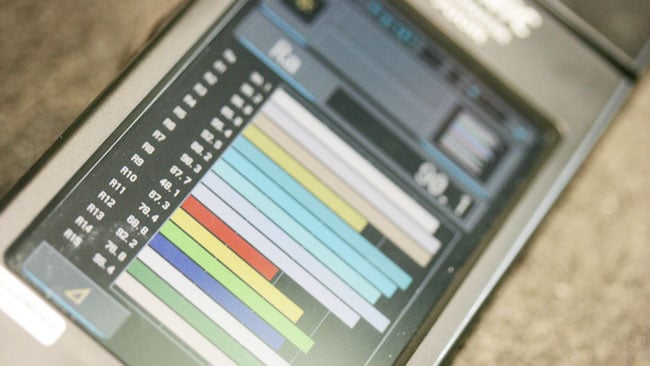 Colorimetry can be a problem with LED, especially at the cheaper end of the market.
Colorimetry can be a problem with LED, especially at the cheaper end of the market.
But this is the high end, at the highest currently available LED power densities, and based on the assumption that we want hard light. Taking a fresnel, either LED, tungsten or HMI, and diffusing it is a horribly inefficient approach. Three sets of four-foot, four-bank Kino Flos (for the sake of something familiar and easily rentable), which develop 300 watts each from their four high-ouput 75-watt tubes, would cost roughly the same, develop the same overall power. Even with light diffusion sufficient to approximate, say, a fresnel on 8-by-8 foot diffuser, they'd probably motivate more useful photons per watt of power consumed.
Cheaper, less expensively branded fluorescent lights are even harder to turn down. CineLight's four-foot, four-bank equivalent goes for the equivalent of around a third the price of a Kino-Flo, which absolutely obliterates any other technology's value proposition for soft light of any colour temperature. Replacement LED tubes that will fit Kino-Flo and similar fittings are available, although the cost of making that change, with good colour performance, can be adjacent to the cost of a complete new device.
Hard and soft, tungsten and daylight
It is, then, a complex area. Let's break light sources down broadly into four areas: hard and soft, each in tungsten and daylight. For hard tungsten light, LED is massively more efficient, but massively more expensive. Productions would need to be using large tungsten light sources for long periods or in places where power is expensive (many studios or locations requiring a generator), before LED made economic sense, although such circumstances are common in studio television production. For soft light, any fluorescent other than absolutely the top brands are cheaper and about as efficient as LED or HMI for any colour temperature. The news in 2015-16 is that LED is now just beginning to compete with HMI, in some circumstances, for hard daylight.
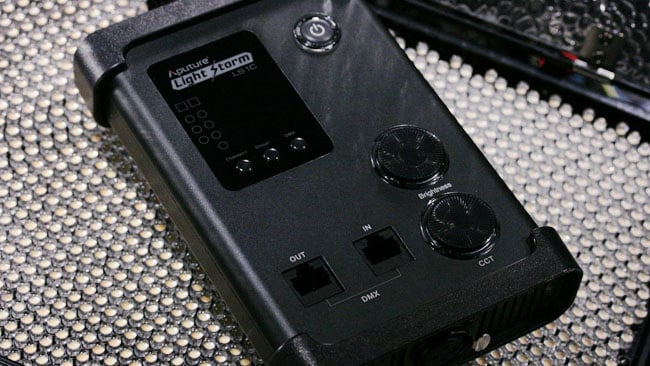 Small, highly portable lighting, such as this Aputure Lightstorm LS1C, has no equivalent in any other technology.
Small, highly portable lighting, such as this Aputure Lightstorm LS1C, has no equivalent in any other technology.
There are important niches where LED wins without question, such as in small handheld or camera-mounted devices. There is no such thing as a fifty-watt HMI (there are broadly equivalent things, but they're much more expensive than LED of similar capability). There is also no such thing as an 18-kilowatt LED, so at the upper end of the scale, HMI remains king. But LED can be dimmed without shifts in colour temperature and it can be a bit more convenient, often lacking the bulky ballast of an HMI. In some circumstances, even small efficiency gains can be very worthwhile, such as news studios where lighting runs for long periods and where tungsten lighting creates significant air conditioning costs. There are also interesting special applications, such as the sticky strip which infests the underside of shelves and cabinets in every sci-fi, medical or scientific set in a major motion picture at present. Even so, LED is, as of the beginning of 2016, still not a technology for universal application. It's interesting and it has unique selling points and improvements are continuously evolving – but it's worth evaluating your situation in the context of exactly what it's best at.
Tags: Production


Comments